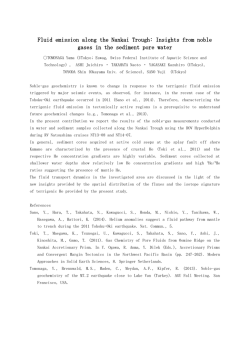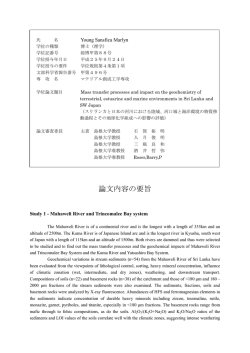
Research Trends and Results Preparation of Sediment Balance
Research Trends and Results Preparation of Sediment Balance Map by Grain Size Group for Promotion of Comprehensive Sediment Management HATTORI Atsushi (Ph.D.), Head; FUKUSHIMA Masaki (Ph.D.), Senior Researcher; KOBAYASHI Katsuya, Researcher; MASUYA Shigekazu, Guest Research Engineer River Division, River Department Keywords: sediment transport system, sediment balance, grain size group decreasing for the same. Accordingly, for example, in mountainous area (including branch rivers), the amount of transfer to a river channel is obtained by deducting the amount of "blue" from "red." With this method, it is possible to grasp the relations between sediment balance in a river channel and the amount of transfer between areas. In the figure, for gravel, gravel extraction from the river channel is estimated to have a greater effect on degradation of the riverbed compared with dam sedimentation. Furthermore, for sand and silt / clay, gravel extraction from the river channel has little effect and dam sedimentation is estimated to have a direct effect on the amount of transfer to coastal areas. In the future, we plan to prepare sediment balance maps for each of the 109 river systems with analyses similar to above and utilize them for promoting ≪土砂収支図≫ comprehensive sediment management for each river. ≪土砂収支図≫ ≪土砂収支図≫ 3 単位:【千m 3/年】 単位:【千m3 /年】 /年】 単位:【千m 評価期間: S33 ~ H18 評価期間: S33 S33 ~ ~ H18 H18 Downstream 1958 ~ 2006 / Coastal (西暦): 1958 1958 ~ ~ 2006 2006 (西暦): area 評価期間: River channel (西暦): 河道部 Branch 支川river 礫 の 土 砂 収 支 図 礫の の土 土砂 砂収 収支 支図 図 礫 1,200 1,200 1,200 下流・海岸部 Legend 凡例 Amount of 河道部への transfer to river 受け渡し量 channel : : 400 上 400 上 400 流 流 200 200 200 か か ら000 ら 下 下 -200 -200 -200 流 流 -400 -400 -400 へ へ の の 1,200 1,200 1,200 土 土 1,000 砂 砂 1,000 1,000 受 受 800 800 800 け け 600 600 渡 渡 600 し 400 400 し 400 量 量 200 200 を 200 を 増000 減 加 少 -200 -200 -200 さ さ -400 -400 せ せ -400 る る 1,200 1,200 1,200 方 方 1,000 1,000 向 向 1,000 に 800 800 に 800 働 働 600 600 600 く く 400 も 400 も 400 の の 200 200 0 00 -200 -200 -200 -400 -400 -400 砂 の 土 砂 収 支 図 砂の の土 土砂 砂収 収支 支図 図 砂 1,200 1,200 1,200 砂 400 400 400 200 200 200 0 00 -200 -200 -200 -400 -400 -400 シ ル ト ・ 粘 土 の 土 砂 収 支 図 シル ルト ト・ ・粘 粘土 土の の土 土砂 砂収 収支 支図 図 シ 1,200 1,200 1,200 1,000 1,000 1,000 800 800 800 600 600 600 400 400 400 200 200 200 0 00 -200 -200 -200 -400 -400 -400 [千m3/年] [千m3/年] [千m3/年] 土 砂 生 産 域 土砂 砂生 生産 産域 域 土 ~ ダ ム 流 域 ~ダ ダム ム流 流域 域 ~ 支 川 群 支川 川群 群 支 河 道 容 積 変 化 量 河道 道区 区域 域 河 ( 直 轄 管 理 区 間 ) (直 直轄 轄管 管理 理区 区間 間) ) ( 下 流 へ の 給 砂 量 下流合流点又は 下流合流点又は Sand feeding to 下流合流点又は 海岸への供給量(-) 海岸への供給量(-) 海岸への供給量(-) downstream 河 道 外 搬 出 入 量 河道区域 in river Changes 実質的な 実質的な 実質的な channel volume 河道容積増加量(+) 河道容積増加量(+) 河道容積増加量(+) Gravel extraction 砂利採取量(-) 砂利採取量(-) 砂利採取量(-) 砂 利 採 取 量 Amount of transfer 河道搬出(入)量(-) 河道搬出(入)量(-) 河道搬出(入)量(-) river channel outside 支 川 等 堆 砂 量 SG境界等堆積量 Sedimentation SG境界等堆積量in SG境界等堆積量 (-) (-) river, etc. branch (-) ダ ム 堆 砂 量 ダム堆砂量(-) 土砂生産量(+) 土砂生産量(+) yield Sediment 土砂生産量(+) 土 砂 生 産 量 sedimentation Dam ダム堆砂量(-) ダム堆砂量(-) 3 シ ル ト ・ 粘 土 [千m3/年] [千m3/年] m /year thousand [千m3/年] Silt / clay 3 [千m3/年] [千m3/年] [千m3/年] m /year thousand 1,000 1,000 1,000 800 800 800 600 600 600 海 岸 ・ 合 流 点 海岸 岸・ ・合 合流 流点 点 海 200 0 00 -200 -200 -200 -400 -400 -400 砂利採取量 砂利採取量 砂利採取量 (特定採取)(-) (特定採取)(-) (特定採取)(-) 3 [千m3/年] [千m3/年] m /year thousand [千m3/年] 800 800 800 600 600 600 400 400 400 200 200 200 : Decrease in the amount of sediment transfer from upstream to downstream 1,200 1,200 1,200 1,000 1,000 1,000 800 800 800 600 600 600 1,000 1,000 1,000 砂利採取量 砂利採取量 砂利採取量 (指定区間)(-) (指定区間)(-) (指定区間)(-) 礫 Sand 黒 部 川 水 系 黒部 部川 川水 水系 系 Mountainous 黒 山地部 area 砂防土砂流出 砂防土砂流出 砂防土砂流出 抑制量(-) 抑制量(-) 抑制量(-) Gravel 黒 部 川 水 系 黒部 部川 川水 水系 系::: 黒 : Increase in the amount of sediment transfer from upstream to downstream 1. Importance of organization of basic information for comprehensive sediment management Comprehensive sediment management means to take drastic measures that connect different areas from a viewpoint of "sediment transport system," i.e., a group of areas connected in terms of sediment transfer, by removing the limitation of area-specific measures, such as for mountains, river channels, and coastal areas with regard to sediment-related issues including disaster prevention and environmental conservation. This concept was proposed a long time ago but is not yet established in the practice of river management. One reason for that is that it takes much time to collect and organize the data from previous surveys and analyses, and identify sediment movement for the scale of a sediment transport system that is based comprehensive sediment management. The circumstances giving rise to such reason are as follows. 1) Record periods, resolutions (spatial / temporal observation intervals, data acquisition methods, etc.), and quality (e.g. planned value or actual value) of the observations and other data are not unified mainly because different entities performed projects in different areas, and the scale and location of projects changed according to social, economic, or other situations. 2) Under such constraints, it requires experience to organize and analyze data with an approach to identifying the relevance between each issue and sediment movement according on the scale of a sediment transport system. Therefore, we decided to collect relevant data in a retrospective and comprehensive manner, and create a sediment balance map that reflects the status of sediment transfer in mountainous area (including dams) and coastal areas based on the sediment balance of river channels connected to those areas in the 109 river systems managed by the country. 2. Preparation of sediment balance map by grain size group as basic information A sediment balance map indicates dam sedimentation, branch river sedimentation, transfer of sediment from the river channel in river development or maintenance, gravel extraction, increase in channel volume calculated from changes in river channel shape, and sediment yield estimated from geology, etc. Each of these quantities is classified according to grain size groups (gravel, sand, silt / clay) and indicated as an annual average value. When the color of a bar indicating the amount is "red," it means increasing transfer from mountain to river channel or from river channel to coast, and when "blue," it means Fig.: Example of Sediment Balance Map by Grain Size Group
© Copyright 2026

